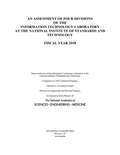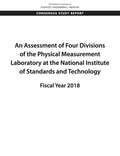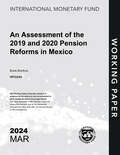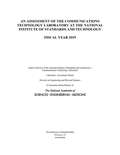- Table View
- List View
An Assessment of Four Divisions of the Information Technology Laboratory at the National Institute of Standards and Technology: Fiscal Year 2018
by Engineering Medicine National Academies of SciencesAn Assessment of Four Divisions of the Information Technology Laboratory at the National Institute of Standards and Technology: Fiscal Year 2018 assesses the scientific and technical work performed by four divisions of the National Institute of Standards and Technology (NIST) Information Technology Laboratory. This publication reviews technical reports and technical program descriptions prepared by NIST staff and summarizes the findings of the authoring panel.
An Assessment of Four Divisions of the Physical Measurement Laboratory at the National Institute of Standards and Technology: Fiscal Year 2018
by Engineering Medicine National Academies of SciencesAn Assessment of Four Divisions of the Physical Measurement Laboratory at the National Institute of Standards and Technology: Fiscal Year 2018 assesses the scientific and technical work performed by four divisions of the National Institute of Standards and Technology (NIST) Physical Measurement Laboratory. This publication reviews technical reports and technical program descriptions prepared by NIST staff and summarizes the findings of the authoring panel.
An Assessment of Illness in U.S. Government Employees and Their Families at Overseas Embassies
by Division on Engineering and Physical Sciences National Academies of Sciences, Engineering, and Medicine Health and Medicine Division Standing Committee to Advise the Department of State on Unexplained Health Effects on U.S. Government Employees and Their Families at Overseas EmbassiesIn late 2016, U.S. Embassy personnel in Havana, Cuba, began to report the development of an unusual set of symptoms and clinical signs. For some of these patients, their case began with the sudden onset of a loud noise, perceived to have directional features, and accompanied by pain in one or both ears or across a broad region of the head, and in some cases, a sensation of head pressure or vibration, dizziness, followed in some cases by tinnitus, visual problems, vertigo, and cognitive difficulties. Other personnel attached to the U.S. Consulate in Guangzhou, China, reported similar symptoms and signs to varying degrees, beginning in the following year. As of June 2020, many of these personnel continue to suffer from these and/or other health problems. Multiple hypotheses and mechanisms have been proposed to explain these clinical cases, but evidence has been lacking, no hypothesis has been proven, and the circumstances remain unclear. The Department of State asked the National Academies to review the cases, their clinical features and management, epidemiologic investigations, and scientific evidence in support of possible causes, and advise on approaches for the investigation of potential future cases. In An Assessment of Illness in U.S. Government Employees and Their Families at Overseas Embassies, the committee identifies distinctive clinical features, considers possible causes, evaluates plausible mechanisms and rehabilitation efforts, and offers recommendations for future planning and responses.
An Assessment of Mine Legacies and How to Prevent Them: A Case Study from Latin America (SpringerBriefs in Environmental Science)
by Vladimir Pacheco CuevaThis book seeks to enrich the growing literature on mine legacies by examining a case study of a small abandoned mine in Latin America. Using a combination of Rapid Rural Appraisal and secondary source analysis, this study assessed some of the most damaging legacies of the San Sebastian mine in eastern El Salvador, compared the country's mine closure legislation against world's best practice standards and provided strategies for awareness, prevention and remediation. The most damaging legacy to the environment is that of Acid Mine Drainage (AMD) contamination of the local river. The impact of AMD is felt well beyond the mining district and the costs of prevention and remediation were found to be significant. Apart from environmental legacies, the mine also left a number of socio-economic legacies including: limited access to non-polluted water that results in San Sebastian residents devoting a high proportion of their income in obtaining water, lost opportunities due to the cessation of mining, uncertain land tenure situation and increasing growth of ASGM activities that exacerbate already existing environmental pollution due to use of mercury. The study also found that the state's capacity to ensure compliance with the law is very weak and that in many important respects the country's current legal framework does not meet world's best practice when it comes to mine closure requirements. The findings are important because they demonstrate that the lack of closure planning can lead to private operators socializing the costs of pollution. The study also shows that the lack of state capacity may result in extractive projects becoming socio-economic liabilities in the long term.
An Assessment of Native Seed Needs and the Capacity for Their Supply: Final Report
by Committee on National Statistics Board on Agriculture and Natural Resources Division of Behavioral and Social Sciences and Education Division on Earth and Life Studies National Academies of Sciences, Engineering, and Medicine Committee on an Assessment of Native Seed Needs and CapacitiesExtreme weather and wildfires, intensified by climate change, are damaging the native plant communities of landscapes across the United States. Native plant communities are foundational to thriving ecosystems, delivering goods and services that regulate the environment and support life, provide food and shelter for a wide range of native animals, and embody a wealth of genetic information with many beneficial applications. Restoring impaired ecosystems requires a supply of diverse native plant seeds that are well suited to the climates, soils, and other living species of the system. This report examines the needs for native plant restoration and other activities, provides recommendations for improving the reliability, predictability, and performance of the native seed supply, and presents an ambitious agenda for action. An Assessment of Native Seed Needs and the Capacity for Their Supply considers the various challenges facing our natural landscapes and calls for a coordinated public-private effort to scale-up and secure a cost-effective national native seed supply.
An Assessment of Naval Hydromechanics Science and Technology
by Naval Studies Board National Research CouncilAn Assessment of Naval Hydromechanics Science and Technology
An Assessment of Non-Lethal Weapons Science and Technology
by Technology Committee for an Assessment of Non-Lethal Weapons ScienceNon-lethal weapons (NLWs) are designed to minimize fatalities and other undesired collateral damage when used. Events of the last few years including the attack on the USS Cole have raised ideas about the role NLWs can play in enhancing support to naval forces. In particular to what extent and in what areas should Department of the Navy (DoN) -sponsored science and technology (S&T) provide a research base for developing NLW capabilities? To assist with this question and to evaluate the current NLWs program, the Joint Non-Lethal Weapons Directorate (JNLWD) and the Office of Naval Research (ONR) requested the National Research Council perform an assessment of NLWs science and technology. The report presents the results of that assessment. It discusses promising NLW S&T areas, development accomplishments and concerns about NLW, and series of recommendations about future NLW development and application.
An Assessment of Selected Divisions of the National Institute of Standards and Technology Information Technology Laboratory: Fiscal Year 2024
by Division on Engineering and Physical Sciences Laboratory Assessments Board National Academies of Sciences, Engineering, and Medicine Panel on Assessment of the National Institute of Standards and Technology (NIST) Information Technology LaboratorySince 1959, the National Institute of Standards and Technology (NIST) has annually solicited the National Academies of Sciences, Engineering, and Medicine to convene expert panels to evaluate the quality, effectiveness, and resource sufficiency of NIST’s six measurement and standards laboratories. This report provides an assessment of the NIST Information Technology Laboratory (ITL) focusing on technical programs, scientific and technical expertise portfolio, facilities, equipment, and human resources support, and program dissemination.
An Assessment of Selected Divisions of the Physical Measurement Laboratory at the National Institute of Standards and Technology: Fiscal Year 2021
by Division on Engineering and Physical Sciences Laboratory Assessments Board National Academies of Sciences, Engineering, and Medicine Committee on NIST Technical Programs Panel on Assessment of Selected Divisions of the Physical Measurement Laboratory at the National Institute of Standards and TechnologyAt the request of the National Institute of Standards and Technology (NIST), the National Academies of Sciences, Engineering, and Medicine has, since 1959, annually assembled panels of experts from academia, industry, medicine, and other scientific and engineering environments to assess the quality and effectiveness of the NIST measurements and standards laboratories, as well as the adequacy of the laboratories' resources. This report assesses the scientific and technical work performed by the NIST Physical Measurement Laboratory in the Quantum Measurement Division, Radiation Physics Division, Sensor Science Division, Microsystems and Nanotechnology Division, and Nanoscale Device Characterization Division.
An Assessment of Selected Programs at the National Institute of Standards and Technology Engineering Laboratory: Fiscal Year 2020
by Division on Engineering and Physical Sciences Laboratory Assessments Board National Academies of Sciences, Engineering, and Medicine Committee on NIST Technical Programs Panel on Review of the Engineering Laboratory at the National Institute of Standards and TechnologyNational Institute of Standards and Technology (NIST) Engineering Laboratory has a long and distinguished record of technological leadership, innovation, and experience in providing analysis and solutions to large and small problems. Engineering Laboratory research quality is exemplified by the programs’ science-based tools and outputs. This report assesses the scientific and technical work performed by the NIST Engineering Laboratory and presents findings, conclusions, and recommendations to advance the mission and vision of NIST with a focus on strategic thinking and planning to support long-term efforts.
An Assessment of Selected Research Programs and Goals of the Engineering Laboratory at the National Institute of Standards and Technology: Fiscal Year 2024
by Division on Engineering and Physical Sciences Laboratory Assessments Board National Academies of Sciences, Engineering, and Medicine Panel on Assessment of the National Institute of Standards and Technology (NIST) Engineering LaboratorySince 1959, the National Institute of Standards and Technology (NIST) has engaged the National Academies of Sciences, Engineering, and Medicine annually to assess the quality, effectiveness, and resource adequacy of NIST’s six measurement and standards laboratories. This report reviews the NIST Engineering Laboratory (EL), evaluating technical programs, assessing EL’s portfolio of scientific and technical expertise, reviewing the adequacy of facilities, equipment, and human resources, and evaluating EL’s effectiveness in disseminating its program outputs.
An Assessment of U.S.-Based Electron-Ion Collider Science
by Engineering Medicine National Academies of SciencesUnderstanding of protons and neutrons, or “nucleons”—the building blocks of atomic nuclei—has advanced dramatically, both theoretically and experimentally, in the past half century. A central goal of modern nuclear physics is to understand the structure of the proton and neutron directly from the dynamics of their quarks and gluons governed by the theory of their interactions, quantum chromodynamics (QCD), and how nuclear interactions between protons and neutrons emerge from these dynamics. With deeper understanding of the quark-gluon structure of matter, scientists are poised to reach a deeper picture of these building blocks, and atomic nuclei themselves, as collective many-body systems with new emergent behavior. The development of a U.S. domestic electron-ion collider (EIC) facility has the potential to answer questions that are central to completing an understanding of atoms and integral to the agenda of nuclear physics today. This study assesses the merits and significance of the science that could be addressed by an EIC, and its importance to nuclear physics in particular and to the physical sciences in general. It evaluates the significance of the science that would be enabled by the construction of an EIC, its benefits to U.S. leadership in nuclear physics, and the benefits to other fields of science of a U.S.-based EIC.
An Assessment of Undersea Weapons Science and Technology
by Technology Committee for Undersea Weapons ScienceAn Assessment of Undersea Weapons Science and Technology
An Assessment of the 2019 and 2020 Pension Reforms in Mexico (Imf Working Papers)
by BonthuisA report from the International Monetary Fund.
An Assessment of the CDC Anthrax Vaccine Safety and Efficacy Research Program
by Committee to Review the CDC Anthrax Vaccine Safety Efficacy Research ProgramIn 1998, the Department of Defense (DoD) began a program of mandatory immunization against anthrax for all military personnel. As the program proceeded, however, some military personnel and their families raised concerns about the safety and efficacy of the anthrax vaccine. Acknowledging both the need to protect military personnel and the concerns about the anthrax vaccine, Congress directed the Centers for Disease Control and Prevention (CDC) to carry out a research program on its safety and efficacy. To assist in the development of this program, CDC requested the Institute of Medicine to convene a committee to review the completeness and appropriateness of the research program. "In An Assessment of the CDC Anthrax Vaccine Safety and Efficacy Research Program, the committee makes an overall assessment of the CDC research plan and reviews the specific studies proposed by CDC in the three areas of efficacy, safety, and acceptability. The committee also notes additional research needs that became evident following the bioterrorist events of 2001 and makes recommendations about the leadership of the research program.
An Assessment of the Center for Neutron Research at the National Institute of Standards and Technology: Fiscal Year 2018
by Engineering Medicine National Academies of SciencesAt the request of the National Institute of Standards and Technology (NIST), the National Academies of Sciences, Engineering, and Medicine has, since 1959 annually assembled panels of experts from academia, industry, medicine, and other scientific and engineering environments to assess the quality and effectiveness of the NIST measurements and standards laboratories, of which there are now seven, as well as the adequacy of the laboratories’ resources. This report assesses the scientific and technical work performed by the National Institute of Standards and Technology (NIST) Center for Neutron Research in the fiscal year 2018. It reviews the organization's technical programs; the portfolio of scientific expertise within the organization; the adequacy of the organization's facilities, equipment, and human resources; and the effectiveness with which the organization disseminates its program outputs.
An Assessment of the Center for Neutron Research at the National Institute of Standards and Technology: Fiscal Year 2021
by Division on Engineering and Physical Sciences Laboratory Assessments Board National Academies of Sciences, Engineering, and Medicine Panel on Assessment of the Center for Neutron Research at the National Institute of StandardsAt the request of the National Institute of Standards and Technology (NIST), the National Academies of Sciences, Engineering, and Medicine has, since 1959, annually assembled panels of experts from academia, industry, medicine, and other scientific and engineering communities to assess the quality and effectiveness of the NIST measurements and standards laboratories. The NIST Center for Neutron Research (NCNR) is one of six major research organizational units consisting of five laboratories and one user facility at NIST. It is one of only three neutron scattering user facilities in the United States, with 30 instruments, supporting roughly one-third of the U.S. neutron scattering instruments and users. This report assesses the scientific and technical work performed by the NCNR, as well as the portfolio of scientific expertise within the organization and dissemination of program outputs.
An Assessment of the Communications Technology Laboratory at the National Institute of Standards and Technology: Fiscal Year 2019
by Engineering Medicine National Academies of SciencesAn Assessment of the Communications Technology Laboratory at the National Institute of Standards and Technology: Fiscal Year 2019 is an independent technical assessment of the quality of the National Institute of Standards and Technology's (NIST's) Communications Technology Laboratory (CTL). It reviews the organization's technical programs, the portfolio of scientific expertise within the organization, the adequacy of the organization's facilities, equipment, and human resources, and the effectiveness by which the organization disseminates its program outputs. This report focuses on CTL priority areas such as public safety communications, trusted spectrum testing, and Next Generation Wireless (5G and Beyond). It also assesses the extent to which CTL applied the recommendations from a 2015 National Academies' report, which describes many of the critical uses of radio communications, provides lab-specific recommendations, and highlights important research priorities for the Boulder, Colorado communications technology laboratory of the Department of Commerce laboratory. This new report also describes the current activities of the Boulder telecommunications laboratories, its strengths and weaknesses as an organization, and its plans for the near future
An Assessment of the Department of Energy's Office of Fusion Energy Sciences Program
by National Research CouncilThe National Academies Press (NAP)--publisher for the National Academies--publishes more than 200 books a year offering the most authoritative views, definitive information, and groundbreaking recommendations on a wide range of topics in science, engineering, and health. Our books are unique in that they are authored by the nation's leading experts in every scientific field.
An Assessment of the Divisions of the Physical Measurement Laboratory at the National Institute of Standards and Technology Located in Boulder, Colorado: Fiscal Year 2023
by Division on Engineering and Physical Sciences Laboratory Assessments Board National Academies of Sciences, Engineering, and Medicine Panel on the Assessment of the National Institute of Standards and Technology (NIST) Physical Measurement LaboratorySince 1959, the National Institute of Standards and Technology (NIST) has annually commissioned the National Academies of Sciences, Engineering, and Medicine to assess its various measurements and standards laboratories. This report appraises the Physical Measurement Laboratory (PML), assessing four divisions of PML situated at the NIST Boulder campus: the Applied Physics Division, the Time and Frequency Division, the Quantum Electromagnetics Division, and the Quantum Physics Division. The report compares the caliber of research at PML with similar international programs to determine whether programs adequately align with its objectives; assesses the range of scientific and technical expertise available within PML; considers the budget, facilities, equipment, and Human Resources to bolster PML technical endeavors and contribute to the fulfillment of its goals; and assesses the efficacy of PML methods for disseminating the products of its work.
An Assessment of the Global Impact of the Financial Crisis
by Philip Arestis Rogéo Sobreira Joséuis OreiroThis topical volume analyzes the impact of the 2008 financial crisis. It considers the origins and explanations of the current crisis, examines the regulatory implications and, with specific focus on developing countries, it provides a strategy for economic growth that can guarantee financial stability in the future.
An Assessment of the International Science and Technology Center: Redirecting Expertise in Weapons of Mass Destruction in the Former Soviet Union
by Office of International AffairsThis report reviews the ISTC's objectives and plans, discussed its activities with U.S. and FSU officials, and met with FSU grant recipients and institute directors. The committee concludes that during its first two years the ISTC was successful and effective in meeting its primary objective, which, in turn, has contributed to the larger goal of diminishing the risk of weapons proliferation. Moreover, the opportunities provided to FSU scientists and engineers do indeed offer meaningful nonweapons-related work, which helps address the demoralization that may otherwise contribute to scientists' being lured into work for unfriendly governments. The committee believes the ISTC has also been successful in addressing its secondary objectives—namely, the solution of national and international technical problems; the support of basic and applied research and technology development for peaceful purposes; and, to a lesser degree, reinforcement of the transition of the FSU to a market-driven economy.
An Assessment of the Material Measurement Laboratory at the National Institute of Standards and Technology: Fiscal Year 2020
by Division on Engineering and Physical Sciences Laboratory Assessments Board National Academies of Sciences, Engineering, and Medicine Panel on Review of the Material Measurement Laboratory at the National Institute of Standards and TechnologyThe Material Measurement Laboratory (MML) of the National Institute of Standards and Technology (NIST) comprises six technical divisions and two offices. The two offices manage programs related to NIST standard reference materials and NIST data products or standard reference data. The technical divisions engage in research and development of the measurement science, standards, technology, and data required to support the nation’s need to design, develop, manufacture, and use materials. These divisions interact extensively with both industry and public institutions to advance the economy and provide tools for the creation of knowledge. This report assesses the scientific and technical work performed by the NIST Material Measurement Laboratory and makes actionable recommendations to support MML in the achievement of its objectives.
An Assessment of the Material Measurement Laboratory at the National Institute of Standards and Technology: Fiscal Year 2023
by Division on Engineering and Physical Sciences Laboratory Assessments Board National Academies of Sciences, Engineering, and Medicine Panel on the Assessment of the National Institute of Standards and Technology (NIST) Material Measurement LaboratorySince 1959, the National Institute of Standards and Technology (NIST) has annually engaged the National Academies of Sciences, Engineering, and Medicine to assemble panels of experts to assess the quality and effectiveness of the NIST measurements and standards laboratories as well as the adequacy of the laboratory resources. This report assesses the Material Measurement Laboratory (MML), with a focus on technical programs, quality of research, scientific and technical expertise, dissemination products and strategies, and how well budget, facilities, equipment, and human resources support technical programs and MML objectives.
An Assessment of the National Institute of Standards and Technology Building and Fire Research Laboratory: Fiscal Year 2010
by National Research Council of the National AcademiesA panel of experts appointed by the National Research Council assessed the scientific and technical work of the Building and Fire Research Laboratory (BFRL) of the National Institute of Standards and Technology (NIST). The scope of the assessment included the following criteria: (1) the technical merit of the current laboratory programs relative to the current state of the art worldwide; (2) the adequacy of the laboratory facilities, equipment, and human resources, as they affect the quality of the laboratory technical programs; and (3) the degree to which the laboratory programs in measurement science and standards achieve their stated objectives and desired impact.














